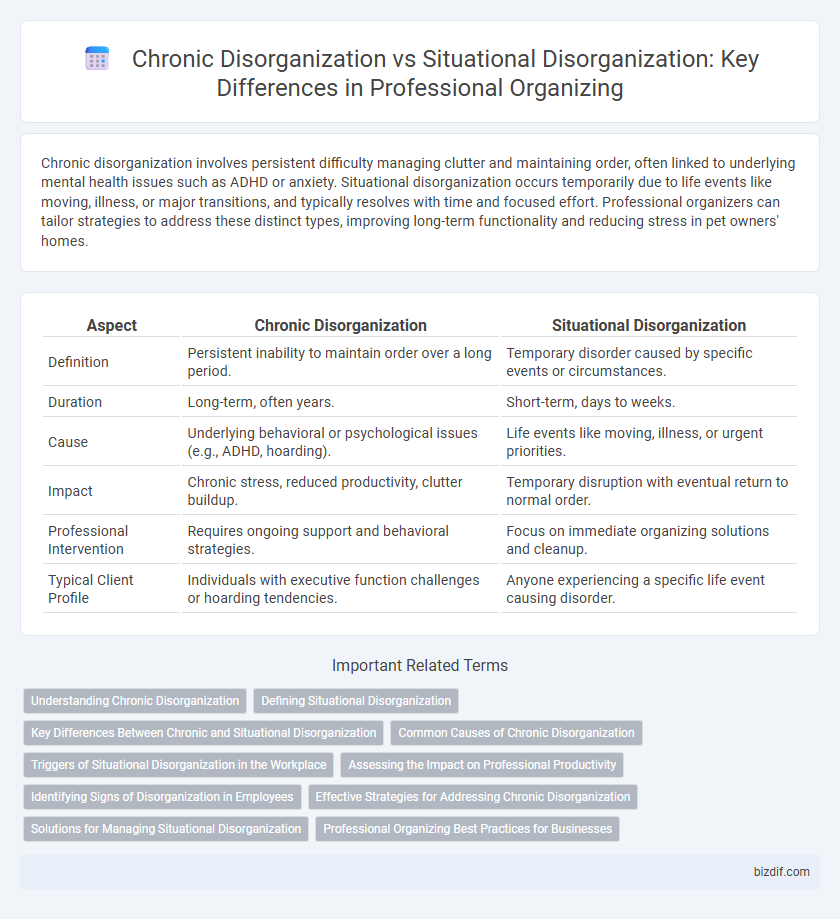Chronic disorganization involves persistent difficulty managing clutter and maintaining order, often linked to underlying mental health issues such as ADHD or anxiety. Situational disorganization occurs temporarily due to life events like moving, illness, or major transitions, and typically resolves with time and focused effort. Professional organizers can tailor strategies to address these distinct types, improving long-term functionality and reducing stress in pet owners' homes.
Table of Comparison
| Aspect | Chronic Disorganization | Situational Disorganization |
|---|---|---|
| Definition | Persistent inability to maintain order over a long period. | Temporary disorder caused by specific events or circumstances. |
| Duration | Long-term, often years. | Short-term, days to weeks. |
| Cause | Underlying behavioral or psychological issues (e.g., ADHD, hoarding). | Life events like moving, illness, or urgent priorities. |
| Impact | Chronic stress, reduced productivity, clutter buildup. | Temporary disruption with eventual return to normal order. |
| Professional Intervention | Requires ongoing support and behavioral strategies. | Focus on immediate organizing solutions and cleanup. |
| Typical Client Profile | Individuals with executive function challenges or hoarding tendencies. | Anyone experiencing a specific life event causing disorder. |
Understanding Chronic Disorganization
Chronic disorganization is a persistent condition characterized by an ongoing inability to maintain an organized environment, often linked to underlying mental health issues such as ADHD, depression, or anxiety. Unlike situational disorganization, which arises from temporary life events like moving, illness, or major transitions, chronic disorganization requires targeted strategies and professional support to address deep-rooted habits and cognitive challenges. Effective professional organizing tailored to chronic disorganization involves creating sustainable systems, behavioral interventions, and sometimes collaborating with mental health professionals to improve long-term functionality.
Defining Situational Disorganization
Situational disorganization occurs due to temporary life events such as moving, illness, or job changes that disrupt normal organization routines. Unlike chronic disorganization, which is ongoing and often linked to mental health issues or hoarding, situational disorganization is typically short-term and resolves as circumstances stabilize. Professional organizers specialize in creating tailored systems to restore order quickly and efficiently during these transitional periods.
Key Differences Between Chronic and Situational Disorganization
Chronic disorganization is characterized by long-term, persistent clutter often linked to underlying psychological issues such as ADHD or hoarding disorder, resulting in widespread disruption of daily life. Situational disorganization occurs due to temporary life events like moving, illness, or major life transitions, causing short-term clutter that is usually resolved once the event passes. Key differences include the duration, underlying causes, and ability to manage clutter, with chronic cases requiring ongoing professional support while situational cases benefit from targeted organizing strategies.
Common Causes of Chronic Disorganization
Chronic disorganization often stems from underlying mental health conditions such as ADHD, executive functioning deficits, and anxiety disorders, which impair a person's ability to maintain order consistently. Unlike situational disorganization triggered by temporary life events like moving or trauma, chronic disorganization is a persistent pattern that affects daily functioning and productivity. Understanding these common causes is crucial for professional organizers to tailor effective intervention strategies that address both emotional and practical challenges.
Triggers of Situational Disorganization in the Workplace
Situational disorganization in the workplace often stems from specific triggers such as sudden workload surges, project deadlines, and unexpected interruptions that disrupt established organizational systems. Employee stress, inadequate time management skills, and lack of clear communication channels also contribute significantly to temporary disarray. Addressing these triggers through structured planning and effective workflow management can restore order and enhance productivity.
Assessing the Impact on Professional Productivity
Chronic disorganization, rooted in persistent behaviors and long-term habits, significantly impairs professional productivity by causing ongoing inefficiencies and missed deadlines. Situational disorganization, often triggered by specific life events or temporary challenges, tends to disrupt workflow temporarily but can be resolved more quickly with targeted organizational strategies. Assessing the impact involves identifying the underlying causes, measuring time lost due to disorganization, and implementing tailored productivity solutions to restore efficiency.
Identifying Signs of Disorganization in Employees
Chronic disorganization in employees often manifests through persistent clutter in workspaces, missed deadlines, and difficulty prioritizing tasks, indicating deeper behavioral patterns rather than isolated incidents. Situational disorganization arises from temporary stressors such as workload spikes or personal challenges, leading to short-term lapses in organization and productivity. Identifying these signs through consistent observation and employee feedback is crucial for tailored interventions that enhance workplace efficiency and well-being.
Effective Strategies for Addressing Chronic Disorganization
Chronic disorganization is characterized by long-term difficulty maintaining order due to underlying habits, emotional barriers, or mental health challenges, whereas situational disorganization arises from temporary life events or transitions. Effective strategies for addressing chronic disorganization involve personalized action plans incorporating cognitive-behavioral techniques, consistent habit-building routines, and ongoing emotional support from professional organizers. Utilizing digital tools for task management and establishing clear, sustainable organizational systems ensures long-term success and prevents relapse.
Solutions for Managing Situational Disorganization
Situational disorganization often arises from temporary life events such as moving, illness, or workload spikes, requiring flexible and short-term solutions. Implementing targeted time management techniques, creating priority-based task lists, and setting specific deadlines can effectively restore order during chaotic periods. Utilizing professional organizing services to develop customized action plans helps clients regain control and maintain organization until the situation resolves.
Professional Organizing Best Practices for Businesses
Chronic disorganization in businesses often results from deep-rooted behavioral patterns impacting productivity, while situational disorganization typically stems from temporary events like office relocations or project deadlines. Professional organizing best practices emphasize tailored systems to address persistent clutter through habit transformation and customized workflow strategies, ensuring sustainable order. Implementing consistent maintenance protocols and clear organizational standards mitigates situational disruptions, enhancing overall business efficiency.
Chronic disorganization vs situational disorganization Infographic

 bizdif.com
bizdif.com